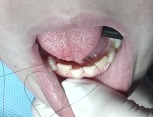Tongue Tie
Tongue tie is diagnosed during physical examination. This is a rare (incidence 3-4%) and definite congenital abnormality. This can be identified by the fact that the tongue is anchored to the floor of the moth by a tight band of tissue.
Tongue is a highly mobile organ made up of longitudinal, horizontal, vertical and transverse intrinsic muscle bundles. The extrinsic muscles are the fan shaped genioglossus which is inserted into the medial part of the tongue and teh styloglossus and hyoglossus which insert in to the lateral portion of the tongue. Ths sublingual frenulum is a fold of mucosa connecting the midline of the inferior surface of the tongue to the floor of the mouth. In tongue tie the frenulum is actually thick, tight and short.
Tongue tie can be diagnosed in an infant who has difficulty in protruding the tongue over the lower lip and gum ridge. This commonly cause pain and soreness of nipple while the baby is breast fed.
Classification of Tongue tie:
Tongue tie is classified into 4 grades. Grades 1 and 2 are anteriorly attached frenulum while in grade 3 and 4 the frenulum is posteriorly attached.
Class I / Grade I tongue tie:
This is the real tongue tie and the tongue is classically heart shaped. The frenulum attaches to the tip of the tonge hindering tongue movement to a great extent.
Class II / Grade II tongue tie:
This is also considered as an anterior tongue tie. In this class the frenulum is attached just behind the tip of the tongue. The tongue is not heart shaped but the tongue tie is clearly visible.
Class III / Grade III tongue tie:
This is considered to be posteriorly attached frenulum. A thin membrane is seen in the frenulum, and this is the difference between class III and class IV.
Class IV / Grade IV tonge tie:
This is also a posterior tongue tie without the presence of thin membrane in the frenulum. These patients are able to elevate the front and sides of the tongue but the mid tongue cannot be elevated. This type of tongue tie is commonly missed.
Problems due to tongue tie:
1. Infants with tongue tie have difficulty in breast feeding as the mother will develop sore nipples because the child finds it difficult to attach its mouth to the nipple. This would result in the mother terminting breast feeding prematurely causing various problems to the child.
2. Speech defects can also occur due to tongue tie. This can cause dysarthria
Treatment:
This is indicated if the child has feeding problems
The child has speech problems (dysarticulation)
Surgery:
This procedure involves frenotomy or fenuloplasty.
Frenotomy:
This is a simple surgical procedure which can be performed with / without anesthesia. The doctor examines the lingual frenulum and uses a sterile scissors to snip the frenulum free. This procedure is quick and cause only minimal discomfort to the patinet. There are only few nerve endings and blood vessels in this area and hence there is relatively no pain or bleeding during the procedure. Even if bleeding occurs it is going to be only a few drops. The baby can be breast fed immediatly after the procedure.
Compllications:
1. Infection
2. Bleeding
3. Damge to sublingual salivary gland ducts
4. Scarring can reattach the tongue back to the floor of the mouth
Frenuloplasty:
This is a more extensive procedure needing anesthesia. General anesthesia is usually preferred in children. This procedure is indicated when the frenulum is too thick for frenotomy. The frenulum is cut using 11 blade or fine scissors. It is absolutely essential for the surgeon to get through the posterior component of the tongue tie for the procedure to be effective. The tongue tie that has been fully released has a diamond shaped wound. If there is no diamond shaped wound then the release is considered to be incomplete. The wound is closed with absorbable suture material like 3 -0 chromic catgut.


